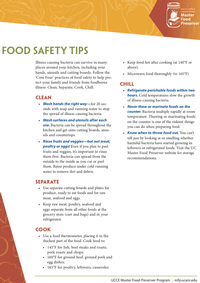Food Safety
Revised June 8, 2021
NOTE: Research is ongoing - recommendations may change. Please refer to the United States Department of Agriculture (USDA) Food Safety and Inspection Service (FSIS) for the most current recommendations: FSIS.USDA.gov and FoodSafety.gov
This food safety page is all about preventing food poisoning. The science behind food safety is understanding which microorganisms are associated with food; which of those can cause illness (pathogens); how they spread; and what conditions affect their growth rate. Food handling guidelines seek to minimize the spread and limit growth of bacteria that are associated with foodborne illness.
Excerpts from FSIS.USDA.gov How Temperatures Affect Food
Bacteria exist everywhere in nature. They are in the soil, air, water and the foods we eat. When bacteria have nutrients (food), moisture, time and favorable temperatures, they grow rapidly, increasing in numbers to the point where some can cause illness.
Bacteria grow most rapidly in the range of temperatures between 40°F and 140°F, doubling in number in as little as 20 minutes. This range of temperatures is often called the "Danger Zone."
If raw meats have been mishandled (left in the "Danger Zone" too long), bacteria may grow and produce toxins which can cause foodborne illness. Those toxins that are heat resistant are not destroyed by cooking. Therefore, even though cooked, meat and poultry mishandled in the raw state may not be safe to eat even after proper preparation.
What can you do to keep your family's food safe from harmful bacteria?
![Safe Handling of Fruits & Vegetables [UCANR #21590] Safe Handling of Fruits & Vegetables [UCANR #21590]](//ucanr.edu/sites/MFPOC/files/342468display.png) Avoid Unsafe Food and Water
Avoid Unsafe Food and Water
![Safe Handling of Fruits & Vegetables [UCANR #21590] Safe Handling of Fruits & Vegetables [UCANR #21590]](http://ucanr.edu/sites/MFPOC/files/342468display.png)
- Don't eat food if you question its safety.
See FDA.gov Safety Recalls, Market Withdrawls and Safety Alerts. - Treat water if in a questionable area or if a disaster hits and water pipes may be broken.
- If you grow food at home, read Food Safety in Your Home Vegetable Garden (UCANR Publication #8366) for ways to reduce the risk of contaminating your home-grown food.
- Wash fruits and vegetables, but not meat and poultry. Read "Safe Handling" [UCANR #21590] for steps to follow when selecting and storing fruits and vegetables to be sure they are not contaminated with harmful bacteria.
Note: Infants, the elderly, pregnant women and anyone with a compromised immune system is at greater risk.
Follow Food Handling Guidelines
excerpt from USDA FSIS Food Safety Education Food Safety Basics

- CLEAN - Wash hands[, utensils,] and surfaces often. [Wash fruits and vegetables, but not meat, poultry, or eggs.]
- SEPARATE - [Be smart. Keep foods apart.] Don't cross-contaminate.
- COOK - Cook [and reheat] to proper temperatures, checking with a food thermometer. [Microwave food thoroughly (165°F or above). Keep food hot (140°F or above) after cooking.]
- CHILL - Refrigerate [(40°F or below) and freeze (0°F or below)] promptly. [Thaw or marinate meat, poultry, and seafood in the refrigerator. Know when to throw it out.]
Jump to [Top of page] [CLEAN] [SEPARATE] [COOK] [CHILL] [More]
 CLEAN
CLEAN

Excerpts from FoodSafety.gov Clean: Wash Hands, Utensils, and Surfaces Often
Germs that can make you sick can survive in many places around your kitchen, including your food, hands, utensils, cutting boards, and countertops.
Wash your hands the right way:
- Use plain soap and water—skip the antibacterial soap—and scrub the backs of your hands, between your fingers, and under your nails for at least 20 seconds. Need a timer? Hum the “Happy Birthday” song from beginning to end twice.
- Rinse hands, then dry with a clean towel.
- Wash your hands often, especially during these key times when germs can spread:
- Before eating
- Before, during, and after preparing food
- Before and after treating a cut or wound
- Before and after caring for someone who is sick
- After handling raw meat, poultry, seafood, or their juices, or uncooked eggs
- After blowing your nose, coughing, or sneezing
- After using the toilet
- After touching garbage
- After changing diapers or cleaning up a child who has used the toilet
- After touching an animal, animal feed, or animal waste
- After handling pet food or pet treats.
Wash surfaces and utensils after each use:
- Wash cutting boards, dishes, utensils, and countertops with hot, soapy water, especially after they’ve held raw meat, poultry, seafood, or eggs.
- Wash dish cloths often in the hot cycle of your washing machine.
Wash fruits and vegetables, but not meat, poultry, or eggs:
- Cut away any damaged or bruised areas, then rinse fruits and vegetables under running water without soap, bleach, or commercial produce washes.
- Scrub firm produce like melons or cucumbers with a clean produce brush.
- Dry produce with a paper towel or clean cloth towel.
- Don’t wash meat, poultry, eggs, or seafood to avoid spreading harmful germs around your kitchen.
- Produce labeled as “pre-washed” does not need to be washed again.
![COOK - Cook [and reheat] to proper temperatures, checking with a food thermometer. COOK - Cook [and reheat] to proper temperatures, checking with a food thermometer.](//ucanr.edu/sites/MFPOC/files/346154display.png) COOK
COOK
![COOK - Cook [and reheat] to proper temperatures, checking with a food thermometer. COOK - Cook [and reheat] to proper temperatures, checking with a food thermometer.](http://ucanr.edu/sites/MFPOC/files/346154display.png)
Excerpts from FoodSafety.gov Cook: Cook to the Right Temperature
Food is safely cooked when the internal temperature is high enough to kill germs that can make you sick. Use a food thermometer to be sure your food is safe.
Cook to the Recommended Safe Minimum Internal Temperature (and Rest Time):
- When you think your food is done, place the food thermometer in the thickest part of the food, making sure not to touch bone, fat, or gristle.
- Reheat cooked foods and leftovers thoroughly to an internal temperature of 165°F or until hot and steaming.
- Bring foods like soups and stews to boiling to make sure that they have reached 212ºF.
Excerpts from FoodSafety.gov Safe Minimum Cooking Temperatures Charts
Follow the guidelines below for minimum cooking temperatures and rest time for meat, poultry, seafood, and other cooked foods. Be sure to use a food thermometer to check whether meat has reached a safe internal temperature that is hot enough to kill harmful germs that cause food poisoning.
| FOOD | TYPE | INTERNAL TEMPERATURE (°F) |
|---|---|---|
| Ground meat and meat mixtures | Beef, pork, veal, lamb | 160 |
| Turkey, chicken | 165 | |
| Fresh beef, veal, lamb | Steaks, roasts, chops Rest time: 3 minutes |
145 |
| Poultry | All Poultry (breasts, whole bird, legs, thighs, wings, ground poultry, giblets, and stuffing) | 165 |
| Pork and ham | Fresh pork, including fresh ham Rest time: 3 minutes |
145 |
| Precooked ham (to reheat) Note: Reheat cooked hams packaged in USDA-inspected plants to 140°F |
165 | |
| Eggs and egg dishes | Eggs | Cook until yolk and white are firm |
| Egg dishes (such as frittata, quiche) | 160 | |
| Leftovers and casseroles | Leftovers and casseroles | 165 |
| Seafood | Fish with fins | 145 or cook until flesh is opaque and separates easily with a fork |
| Shrimp, lobster, crab, and scallops | Cook until flesh is pearly or white, and opaque | |
| Clams, oysters, mussels | Cook until shells open during cooking |
Excerpts from FoodSafety.gov Cook: Cook to the Right Temperature
Microwave food thoroughly (165°F or above):
- Read package directions for cooking and follow them exactly to make sure food is thoroughly cooked.
- If the food label says, “Let stand for x minutes after cooking,” follow the directions — letting microwaved food sit for a few minutes allows food to cook thoroughly as colder areas absorb heat from hotter areas.
- Stir food in the middle of heating. Follow package directions for commercially prepared frozen food; some are not designed to be stirred while heating.
Keep food hot (140°F or above) after cooking:
- If you’re not serving food right after cooking, keep it out of the temperature danger zone (between 40°F -140°F) where germs grow rapidly by using a heat source like a chafing dish, warming tray, or slow cooker.
Jump to [Top of page] [CLEAN] [SEPARATE] [COOK] [CHILL] [More]
 SEPARATE
SEPARATE

Excerpts from the FSIS.UDSA.gov Be Smart. Keep Foods Apart. Don't Cross-Contaminate page. Although it didn't survive the USDA website redesign (03/21), the information remains true.
Cross-contamination is the transfer of harmful bacteria to food from other foods, cutting boards, utensils, etc., if they are not handled properly. This is especially true when handling raw meat, poultry, and seafood, so keep these foods and their juices away from already cooked or ready-to-eat foods and fresh produce. When handling foods, it is important to Be Smart, Keep Foods Apart — Don't Cross-Contaminate. By following these simple steps, you can prevent cross-contamination and reduce the risk of foodborne illness.
When Shopping:
- Separate raw meat, poultry, and seafood from other foods in your grocery-shopping cart.
- Place these foods in plastic bags to prevent their juices from dripping onto other foods.
- It is also best to separate these foods from other foods at check out and in your grocery bags.
When Refrigerating Food:
- Place raw meat, poultry, and seafood in containers or sealed plastic bags to prevent their juices from dripping onto other foods. Raw juices often contain harmful bacteria.
- Store eggs in their original carton and refrigerate as soon as possible.
When Preparing Food:
- Wash hands and surfaces often. Harmful bacteria can spread throughout the kitchen and get onto cutting boards, utensils, and counter tops. To prevent this:
- Wash hands with soap and warm water for 20 seconds before and after handling food, and after using the bathroom, changing diapers; or handling pets.
- Use hot, soapy water and paper towels or clean cloths to wipe up kitchen surfaces or spills. Wash cloths often in the hot cycle of your washing machine.
- Wash cutting boards, dishes, and counter tops with hot, soapy water after preparing each food item and before you go on to the next item.
- A solution of 1 tablespoon of unscented, liquid chlorine bleach per gallon of water may be used to sanitize surfaces and utensils.
- Cutting Boards:
- Always use a clean cutting board.
- If possible, use one cutting board for fresh produce and a separate one for raw meat, poultry, and seafood.
- Once cutting boards become excessively worn or develop hard-to-clean grooves, you should replace them.
- Marinating Food:
- Always marinate food in the refrigerator, not on the counter.
- Sauce that is used to marinate raw meat, poultry, or seafood should not be used on cooked foods, unless it is boiled just before using.
When Serving Food:
- Always use a clean plate.
- Never place cooked food back on the same plate or cutting board that previously held raw food.
Jump to [Top of page] [CLEAN] [SEPARATE] [COOK] [CHILL] [More]
 CHILL
CHILL

Excerpts from FSIS.USDA.gov How Temperatures Affect Food
Properly handled food stored in a freezer at 0°F will be safe...In contrast to freezer storage, perishable foods will gradually spoil in the refrigerator. Spoilage bacteria will make themselves known in a variety of ways. The food may develop an uncharacteristic odor, color and/or become sticky or slimy. Molds may also grow and become visible.
Bacteria grow most rapidly in the range of temperatures between 40°F and 140°F, doubling in number in as little as 20 minutes. This range of temperatures is often called the "Danger Zone."
Because we know how different temperatures affect the growth of bacteria in our food, we can protect ourselves and our families from foodborne illnesses... by following safe food-handling practices.
Excerpts from FoodSafety.gov Chill: Refrigerate and Freeze Food Properly and various FSIS.USDA.gov Food Safety pages.
Beware the Danger Zone (40°F - 140°F)
- When Shopping:
- Purchase refrigerated or frozen items after selecting your nonperishables.
- Refrigerate perishable foods within 2 hours (1 hour when temperatures are above 90°F).
- If out longer, bring a cooler packed with plenty of ice, frozen gel packs or another cold source to keep perishables cold.
- When Preparing Food:
- Never thaw or marinate foods on the counter. The safest way to thaw or marinate meat, poultry, and seafood is in the refrigerator.
- When Traveling with Perishable Food (like sack lunch, party, picnic, camping):
- It is difficult to keep foods hot without a heat source when traveling, so it's best to cook foods before leaving home, cool them, transport them cold, then reheat them before eating.
- Use a cooler packed with plenty of ice, frozen gel packs or another cold source to keep perishables cold.
- Never leave perishable foods in the danger zone for more than 2 hours (1 hour for temperatures above 90°F).
- When Serving Cold Food:
- Cold food should be held at 40°F or colder.
- When serving food at a buffet, keep cold food cold by nesting dishes in bowls of ice or use small serving trays and replace them often.
- Use a food thermometer to check holding temperatures.
- Perishable food should not be left out more than 2 hours at room temperature (1 hour when the temperature is above 90°F).
- When Storing Food:
- Always refrigerate perishable food within 2 hours (1 hour when the temperature is above 90°F).
- Check the temperature of your refrigerator and freezer with an appliance thermometer. The refrigerator should be at 40°F or below and the freezer at 0°F or below.
- Cook or freeze fresh poultry, fish, ground meats, and variety meats within 2 days; other beef, veal, lamb, or pork, within 3 to 5 days.
- Freezing does not destroy harmful germs, but it does keep food safe until you can cook it.
- Leftovers should be placed in shallow containers and immediately put in the refrigerator or freezer for rapid cooling.
- Use most cooked leftovers within 3 to 4 days.
Know When to Throw Out Food:
- Discard any food left out at room temperature for more than 2 hours (1 hour if the temperature was above 90°F).
- Be sure you throw food out before harmful bacteria grow.
- Check Safe Storage Times chart.
Jump to [Top of page] [CLEAN] [SEPARATE] [COOK] [CHILL] [More]
More on Food Safety
Acknowledgment: Above CLEAN - SEPARATE - COOK - CHILL icons open to corresponding tips from a past FSIS.USDA BeFoodSafe campaign.
Handy Quick Reference Brochure (printable trifold):
- Safe Handling of Fruits and Vegetables (UC Davis, 2007)
(Spanish) Manejo Seguro de Frutas y Verduras (UC Davis, 2007)
Recommended Reading (not hot-linked above):
- Food Product Dating (FSIS.USDA)
- Shelf-Stable Food Safety (FSIS.USDA)
- Spice Containers pose Contamination Risk during Food Preparation (Rutgers University)
Reference Collections:
- Food Safety Publications from nationwide university extension programs (UC Master Food Preserver Program)
- Food Safety Videos from nationwide university extension programs (UC Master Food Preserver Program)
Reference Websites:
- Consumer Food Safety at Home (UC Food Safety, Davis)
- Food Safety (CDC.gov)
(Spanish) Seguridad de los Alimentos (CDC.gov) - Food Safety (FSIS.USDA.gov)
- Keep Food Safe (FoodSafety.gov)
(Spanish) Montenga Segurida de los Alimentos (Español.FoodSafety.gov)
Have a food safety question for the USDA?
- Call the USDA Meat and Poultry Hotline toll free at 1-888-MPHotline (1-888-674-6854) for questions about meat, poultry, or egg products.
The Hotline is open year-round Monday through Friday from 10 a.m. to 6 p.m. ET (English or Spanish). - AskUSDA! (replaces AskKaren) - supports call, email and chat
(Spanish) Pregúntele a Karen
Jump to [Top of page] [CLEAN] [SEPARATE] [COOK] [CHILL] [More]

